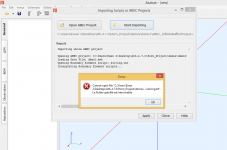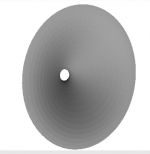Berstis lens was mentioned earlier in the thread. Just in case I'll post it again to further stimulate brain activity 😀
https://www.aes.org/tmpFiles/elib/20211012/19881.pdf
Berstis method doing it enables "channels" without bends. Not sure how one would make the Berstis style channels expanding though so a short pipe section done like this could do?
Patric Bateman mentioned earlier in this thread that the sound of such lens wasn't reported particularly good though...
https://www.aes.org/tmpFiles/elib/20211012/19881.pdf
Berstis method doing it enables "channels" without bends. Not sure how one would make the Berstis style channels expanding though so a short pipe section done like this could do?
Patric Bateman mentioned earlier in this thread that the sound of such lens wasn't reported particularly good though...
Attachments
Last edited:
Regarding the Berstis lens, it's all about implementation, and I think it's not that easy. Due to the non-zero thickness of the walls, which occupy quite a lot of the cross section area, there will be a step change in the cross section, i.e. a reflections both at the input and the output. As illustrated, the walls are not parallel to the wave propagation for the outer channels, which I assume is also not a good thing. As it is, it just can't work very well, IMO.
It's all about the details.
It's all about the details.
Makes sense. Hopefully thin enough vane thickness, what ever a working implementation would be, doesn't end up sounding like a Kazoo 😀
We'll see. I had to interrupt this work at the moment but in the meantime I got some new ideas about how to construct the channels via Bezier curves so that all the previously mentioned conditions are fulfilled.
I just found that 4.7.2 generates ripple.txt in the output directory, it seems usable.Is it already possible to generate an output for the Ripple Tank in Ath 4.7.2?
I had that feeling about the channels getting narrower too.
Interesting with the bezier curves!
Didn't have time to work on it today, but will try again tomorrow.
I think it's a matter of time before it's solved 🙂
Btw the 2x scaled version of the horn worked like a charm between 300 and about 7k and started beaming quite a bit after like anticipated.
Interesting with the bezier curves!
Didn't have time to work on it today, but will try again tomorrow.
I think it's a matter of time before it's solved 🙂
Btw the 2x scaled version of the horn worked like a charm between 300 and about 7k and started beaming quite a bit after like anticipated.
Very interesting! But the channels are crossing each other in the last one. Look at the outer 2 at 10 mm from the throat.
/Anton
/Anton
Yes, that's also why I noted that it still requires tweaking. There are an awful lot of parameters that can be set...
- I think it won't be hard to print, probably from two haves, divided by a plane at e.g. x = 40.
- I think it won't be hard to print, probably from two haves, divided by a plane at e.g. x = 40.
Attachments
Last edited:
Does it matter where the center of the sphere that includes the exit points of the vanes lays?
That would be the virtual center of the conical horn, wouldn't it?
In my effort with grasshopper I used the origin as the center, which presented some limitations....
That would be the virtual center of the conical horn, wouldn't it?
In my effort with grasshopper I used the origin as the center, which presented some limitations....
1.4" throat - initial / meandered channels.
The center lines of the initial channels are simply Bezier cubics. The meandering is then a little bit more complicated.
The center lines of the initial channels are simply Bezier cubics. The meandering is then a little bit more complicated.
Attachments
Last edited:
This is nail-biting interesting. To be able to use a larger CD so that one could reach down to maybe 5-600 Hz but at the same time retain HF performance (FR, DI) would be like finding the holy grail.
//
//
Yeah, isn't bigger membrane of bigger driver part of the volume velocity portion of this equation?
Power = (volume velocity ^ 2) * acoustical impedance
Post #8355
In which case a bigger 2" throat driver with its bigger membrane does the same thing as increased acoustical loading would do being even more effective. The meandering channels would possibly perhaps help with the top end that would be otherwise lost with such a big throat like TNT writes. The loading + pattern control on same device (the holy grail) from another perspective, replacing the loading with bigger membrane to effectively reach same end result. Eagerly waiting first sims!
Heck, this would possibly work pretty nicely for cone drivers as well? As said million times, devil is in the details... can't wait though 🙂
Power = (volume velocity ^ 2) * acoustical impedance
Post #8355
In which case a bigger 2" throat driver with its bigger membrane does the same thing as increased acoustical loading would do being even more effective. The meandering channels would possibly perhaps help with the top end that would be otherwise lost with such a big throat like TNT writes. The loading + pattern control on same device (the holy grail) from another perspective, replacing the loading with bigger membrane to effectively reach same end result. Eagerly waiting first sims!
Heck, this would possibly work pretty nicely for cone drivers as well? As said million times, devil is in the details... can't wait though 🙂
Last edited:
I love the "simplicity"
The bezier curve idea was a good one Mabat!
I'm pretty excited about testing some of this too.
So far the crazy expensive Axi2050 is quite unusable to me.
Have you tried to simulate it in AKABAK?
I'm still having issues importing 2D geometry.
Lines get weirdly interconnected.
The bezier curve idea was a good one Mabat!
I'm pretty excited about testing some of this too.
So far the crazy expensive Axi2050 is quite unusable to me.
Have you tried to simulate it in AKABAK?
I'm still having issues importing 2D geometry.
Lines get weirdly interconnected.
Last edited:
Not yet but I'm working on that. Probably each channel will need its own interior subdomain. For simulation and optimization I think the easiest for the start is to place it in a sphere, i.e. with the reference being a pulsating cap on a sphere - it should be clear how it should perform (can be simulated easily).Have you tried to simulate it in AKABAK?
I plan the first real testing without a waveguide, just the vanes in a large baffle.
First I want to thank you, Mabat, for the amazing job you did for this software !
I tried to run it and open the ABEC project with Akabak but I've got this issue: when I click on "Start importing", it says a file finishing by "solving.txt" is not found (see attached picture).

At least the meshing part is good I think:

Does anybody know what it could come from ?
I tried to run it and open the ABEC project with Akabak but I've got this issue: when I click on "Start importing", it says a file finishing by "solving.txt" is not found (see attached picture).

At least the meshing part is good I think:

Does anybody know what it could come from ?
- Home
- Loudspeakers
- Multi-Way
- Acoustic Horn Design – The Easy Way (Ath4)







